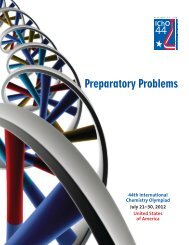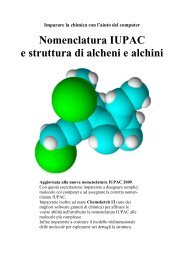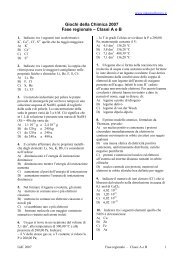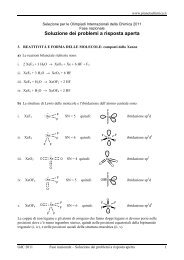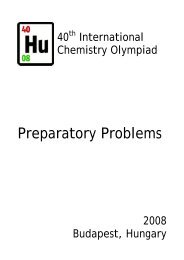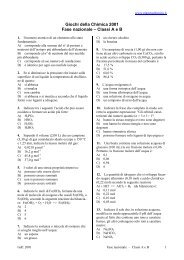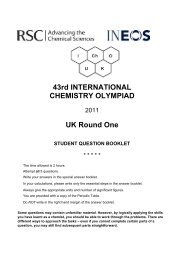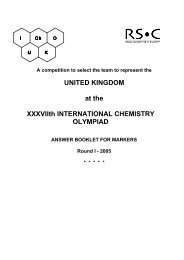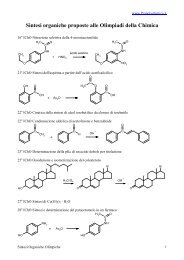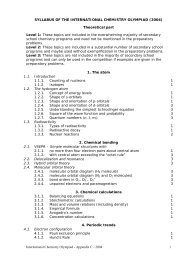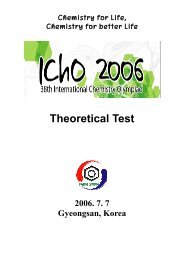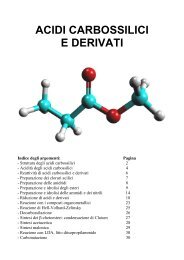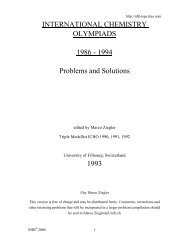Create successful ePaper yourself
Turn your PDF publications into a flip-book with our unique Google optimized e-Paper software.
2. This question is about pollution and the Taj MahalYou should need to refer to the following solubility data to help answer this question.Substance CaCO3 CaSO4 BaCO3 BaSO4Solubility in water –4 –2 –5 –61.3 x 10 4.5 x 10 9.1 x 10 9.4 x 10/ mol dm –3Although calcium carbonate is effectively insoluble in pure water, it reacts with acidicrainwater, thereby accelerating the erosion <strong>of</strong> marble and limestone monuments.(a) Give the equation for the reaction between calcium carbonate and carbonic acid,H 2 CO 3 (aq).In addition to this reaction, the pollutant SO 2 forms SO 3 in the atmosphere, which thendissolves in rainwater forming sulfuric acid. This slowly converts calcium carbonate intosolid calcium sulfate.(b) i) Write the equation for the reaction between calcium carbonate and sulfuric acid.ii) Why does the conversion <strong>of</strong> calcium carbonate into calcium sulfate accelerate theerosion <strong>of</strong> marble and limestone?The life <strong>of</strong> monuments like the Taj Mahal is now being extended by treatment with anaqueous mixture <strong>of</strong> barium hydroxide, Ba(OH) 2 and urea, CO(NH 2 ) 2 . As this solutionsoaks into the porous marble / limestone, the urea slowly hydrolyses forming ammoniaand carbon dioxide. The carbon dioxide released reacts with the barium hydroxideforming barium carbonate.(c) Write the equation for the hydrolysis <strong>of</strong> urea.(d) i) Write the equation for the reaction between barium hydroxide and carbon dioxide.ii) Why does the formation <strong>of</strong> barium carbonate slow down the rate <strong>of</strong> erosion <strong>of</strong> themonument?Finally, surface barium carbonate on the treated monument can react with sulfur dioxidein the air, forming a layer <strong>of</strong> barium sulfate, and carbon dioxide.(e) i) Give the equation for the reaction between barium carbonate and sulfur dioxide, inthe presence <strong>of</strong> oxygen.ii) Will this secondary reaction speed up or slow down the erosion process?Explain briefly.
3. This question is about dissolved oxygen in waterAquatic life can only survivebecause <strong>of</strong> the oxygen gasdissolved in the water;without it, the water rapidlybecomes toxic due todecaying organic matter.Hence it is important tomonitor the dissolved oxygenconcentration (DOC) in riversand lakes – if this falls below5 mg dm –3 , most species <strong>of</strong>fish cannot survive.One <strong>of</strong> the most accurate methods for measuring the DOC in water is the Winkler2+ 3+method. Under alkaline conditions Mn is rapidly oxidised to Mn by dissolved oxygen,producing a pale brown precipitate <strong>of</strong> Mn(OH) 3 . A sample <strong>of</strong> river water is shaken withexcess alkaline Mn 2+ , and the resulting pale brown precipitate is then reacted with anexcess <strong>of</strong> potassium iodide, which it oxidises to iodine. The iodine is then determined bya titration with sodium thiosulfate (Na 2 S 2 O 3 ) solution <strong>of</strong> known concentration.(a) Write balanced symbol equations for:i) the oxidation <strong>of</strong> Mn(OH) 2 to Mn(OH) 3 by aqueous oxygen,ii) the oxidation <strong>of</strong> KI by Mn(OH) 3 ,The equation for the reaction between sodium thiosulfate and iodine is:2Na 2 S 2 O (aq) + I3 2 (aq) Na 2 S 4 O 6 (aq) + 2NaI (aq)(b) Suggest an indicator for the iodine-thiosulfate titration.25.0 cm 3 <strong>of</strong> a sample <strong>of</strong> river water treated in this way required 25.0 cm 3 <strong>of</strong> 0.00100mol dm –3 sodium thiosulfate solution.(c) Calculate the concentration <strong>of</strong> the dissolved oxygen in mg dm –3 .Nitrate(III) ions are found to interfere with this method since they too can oxidise iodideions to iodine. During the reaction, a colourless gas is given <strong>of</strong>f, which instantly turnsbrown on exposure to the air.(d) What is the colourless gas? Give a balanced equation for its reaction in air.(e) Write a balanced equation for the oxidation <strong>of</strong> iodide ions by nitrate(III) ions.In a modification <strong>of</strong> the Winkler method to prevent the interference by nitrate(III) ions, asolution <strong>of</strong> sodium azide, NaN 3 , is added to the river water. During this reaction, twogases are evolved: nitrogen and N 2 O.(f)Write a balanced equation for the reaction between nitrate(III) ions and azide ions inaqueous acid.
4. This question is about Agent OrangeAgent Orange was the name given to thepowerful defoliant used during the VietnamWar. It consisted <strong>of</strong> a 1:1 mixture <strong>of</strong> twoherbicides, ‘2,4-D’ and ‘2,4,5-T’.Shown below is a route for synthesising2,4,5-T.1,2,4,5-tetrachlorobenzene1. Heat with NaOH inmethanol / H 2 O solventunder pressure2. AcidifyX1. Heat with NaOH andchloroethanoic acid at140 ˚C2. Acidify2,4,5-TThe proton NMR spectra for the starting material, 1,2,4,5-tetrachlorobenzene, theintermediate X, and 2,4,5-T are shown over the page.After the first step in the synthesis, if the reaction mixture is acidified not with normalacid, H 3 O + , but with deuterated acid, D 3 O + , then the signal at 5.8 ppm in the 1 H NMRspectrum <strong>of</strong> X disappears. [Deuterium, D, is the 2 H isotope <strong>of</strong> hydrogen.](a) Draw the structure <strong>of</strong> 1,2,4,5-tetrachlorobenzene.(b) Suggest a structure for the intermediate X.(c) Give the systematic name for intermediate X.(d) Draw the structure for X if the reaction mixture had been acidified with D 3 O + instead<strong>of</strong> H 3 O + .(e) Draw the structure <strong>of</strong> chloroethanoic acid.(f)Suggest a structure for 2,4,5-T.(g) On your structure, indicate as far as you are able which hydrogens correspond to whichsignals (A, B, C or D) in the 1 H NMR spectrum <strong>of</strong> 2,4,5-T.Whilst 2,4,5-T is a highly effective herbicide, its commercial use has been discontinueddue to the presence <strong>of</strong> an incredibly toxic impurity called Dioxin which may be formedfrom intermediate X during the synthesis <strong>of</strong> 2,4,5-T.2 mol X + 2 mol NaOH 1 mol Dioxin + 2 mol NaCl + 2 mol H 2 OThe 1 H NMR spectrum <strong>of</strong> Dioxin shows just a single peak at 7.2 ppm.(h) Suggest a structure for Dioxin.
1 H NMR spectrum <strong>of</strong>1,2,4,5-tetrachlorobenzene2Hsolvent (CDCl3)(H 2 O)14 13 12 11 10 9 8 7 6 5 4 3 2 1 ppm1 H NMR spectrum <strong>of</strong> X1H 1H 1Hsolvent(H2O)14 13 12 11 10 9 8 7 6 5 4 3 2 1 ppm1 H NMR spectrum <strong>of</strong> 2,4,5-T2H1H 1H 1Hsolvent(DMSO)A B C D14 13 12 11 10 9 8 7 6 5 4 3 2 1 ppm[The faint lines are the integrals used in working out the relative numbers <strong>of</strong> hydrogens.]
5. This question is about tin pestTin can exists as two stable allotropes:β-tin or white tin, which is metallic, andα-tin or grey tin, which is a non-metal.The conversion from one form to theother occurs at a critical temperature,T c . The conversion from the metallicform to the powdery non-metallic form isknown as tin pest or tin disease, partlybecause the accompanying change indensity may cause ‘warts’ to form on thesurface.The organ at the <strong>Royal</strong> Albert Hallcontains 150 tonnes <strong>of</strong> tin!Tin pest has been suggested as the cause <strong>of</strong> organ pipes disintegrating in certain coldchurches (previously thought to be the work <strong>of</strong> the devil), and even as a possible reasonfor the failure <strong>of</strong> Captain Scott’s expedition to the South Pole, when the tin solder used inthe fuel cans deteriorated.The question refers to the change: white tin grey tinYou should use the following data.atomic distance toΔ f HSdensitynearest neighbour/ kJ mol –1 / J K –1 mol–1 / g cm –3/ pmwhite tin 0 51.4 7.31 302grey tin – 2.09 44.1 5.75 280(a) Calculate the standard enthalpy change, Δ rH, for the change.It is possible to calculate the standard entropy change, Δ r S , for this reaction in a similarway to the above using the standard entropy values, S , given in the table.(b) Calculate Δ rS for this reaction.The feasibility <strong>of</strong> any chemical process at an absolute temperature T can be determinedby calculating the change in the Gibbs energy, Δ r G, for the process at that temperature,whereΔ r G = Δ r H – T Δ r S .If Δ G is less than zero, the process can take place; if is greater than zero, it cannot.r(c) Calculate Δ G for the change white tinrgrey tin at room temperature, 25 °C.(d) Which allotrope <strong>of</strong> tin is stable at room temperature? Justify your answer.(e) Calculate the temperature, T c , at which both allotropes are in equilibrium.(f)Calculate the percentage increase in volume as white tin converts to grey tin.(g) Which allotrope possesses the greater coordination number? Justify your answer.
6. This question is about a supernovaThe electronic ground state (i.e. the lowestelectronic state) <strong>of</strong> a hydrogen atom may bewritten 1s 1 indicating that the single electronresides in the 1s orbital. If sufficient energy isgiven to the atom, the electron may be promotedfrom the 1s orbital to a higher energy orbital,such as the 2p orbital or the 3p orbital.The energy <strong>of</strong> an electron in a hydrogen atom (orany ionized atom with nuclear charge Z and withjust one electron remaining) is given by thefollowing equation:2ZE −Rn= Supernova remnant E0102-72H 2nas photographed by the UV / x-ray telescope Chandra.The energy <strong>of</strong> a free, ionized electron is zero;electrons in the atom have lower energy, hencethe minus sign.In the equation, Z is the number <strong>of</strong> protons in the nucleus (Z = 1 for hydrogen);n is the principal quantum number (n = 1 for the 1s orbital, 2 for the 2s and 2p orbitals,3 for the 3s, 3p and 3d orbitals, etc.);R His the Rydberg constant equal to the ionization energy <strong>of</strong> a hydrogen atom–18(R = 2.179 × 10 J).H(a) Calculate the energy <strong>of</strong> an electron in a 2p orbital in an excited hydrogen atom.(b) Calculate the energy needed to promote the electron in a hydrogen atom from the 1sorbital to the 2p orbital.+(c) Calculate the ionization energy <strong>of</strong> a helium ion, He .When an electron returns from a higher energy orbital to a lower one, energy is given outas light (the cause <strong>of</strong> the familiar flame colours). The frequency <strong>of</strong> the light, f, (in Hz) isrelated to the energy <strong>of</strong> the transition, ΔE, by the equation:–34Δ E = h f (where h is Planck’s constant = 6.626 × 10 J s).(d) Calculate the frequency <strong>of</strong> light for the electronic transition in a hydrogen atom from a2p orbital to the 1s orbital (the so-called Hydrogen Lyman-α line).Supernova remnant E0102-72, located some 200,000 light years away, has been foundto contain more than a billion times the amount <strong>of</strong> oxygen contained in the Earth'soceans and atmosphere. At the incredibly high temperatures in the supernova (manymillions <strong>of</strong> Kelvin), the oxygen atoms are multiply ionized to single electron species, O 7+ .The oxygen was detected by the specific frequency <strong>of</strong> its Lyman-α line (the transitionn = 2 to n = 1).7+(e) Calculate the frequency <strong>of</strong> the O Lyman-α line.(f)Another element present in large quantities has its Lyman-α line at 2.471 × 10 Hz.What element is this?17
7. This question is about ‘asparagus-pee’It has long been known that after eating asparagus,many people can detect an odd odour in their urine.(Whether or not a person can actually smell it isapparently genetic.)In the 19 th century it was thought that thecompound responsible for the smell in so-called‘asparagus-pee’ was methanethiol, CH SH. 3In a more recent study, no methanethiol wasdetected in the vapour from asparagus-pee but twoother sulfur-containing compounds, A and B, wereidentified by mass spectrometry. The M + ion forcompound A is at m/e = 102; for compound B, m/e =150.For comparative purposes, compounds A and B were also prepared in the laboratoryfrom propenoic acid by the following routes.OOOH+ CH 3 SH +RNC(DCC)ONRA+RNHCNHby-productROH+H 2 SWW+CH 3 IXOX+ CH 3 SH +RNC(DCC)NRB+RNHCNHRby-productCompound A reacts with HBr to give Y and with Br 2 to give two isomers, Z1 and Z2.Y is not optically active and has two peaks for its M + ion at m/e = 182 and 184 (1:1 ratio).Z1 and Z2 are enantiomers (optical isomers) and their M + ions have m/e = 260, 262, and264 (ratio 1:2:1).(a) State the role <strong>of</strong> the reagent ‘DCC’: i) catalyst; ii) hydrating agent;iii) dehydrating agent; iv) hydrogenating agent or v) dehydrogenating agent.(b) Suggest structures for compounds A, B, W, X, Y, Z1, and Z2.(c) Both A and B may be hydrolysed in water, releasing methanethiol, (hence the earliersuspicion <strong>of</strong> this compound). Write balanced equations for the hydrolysis reactions <strong>of</strong>both A and B.79[Naturally occurring bromine is a 1:1 mixture <strong>of</strong> Br and 81 Br]




